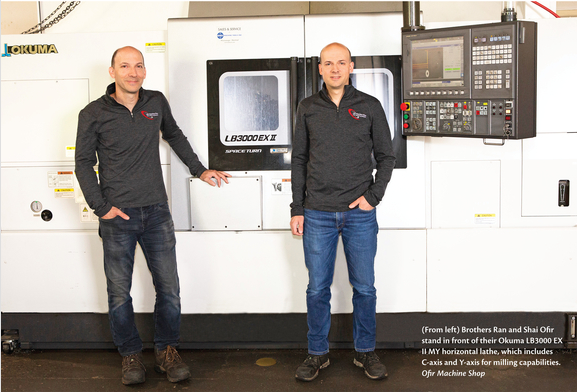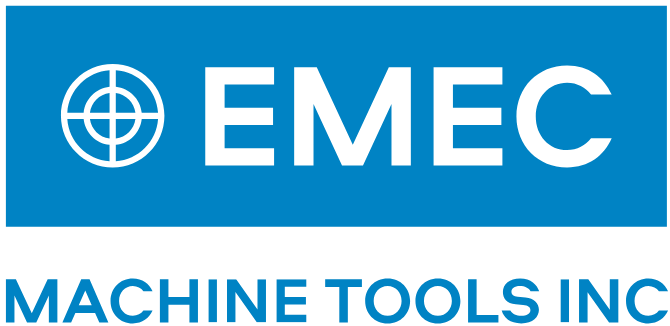
New Multitasking Machine Leads to Significant Efficiency Gains – Customer Testimonial
Ofir Machine Shop Adds Okuma LB3000 EX II
“If our father hadn’t purchased the first CNC machine in the early 80s, where would our shop be today? That really set the tone for how we operate. In the last five years, we’ve really focused on the latest technology for our shop. Our father focused on investing in 2-axis CNC lathes and 3-axis CNC mills. Part of our job is to focus on the multiaxis front, particularly on our lathes. That has really transformed the way that we think about the business, the jobs that we can do, how we price the jobs, and how we’re competing. It’s really changed a lot for us.” – SHAI OFIR
By Canadian Metalworking Technology Ofir Machine Shop’s history dates back to 1965, when it got its start as a manufacturer of components for the military. In the mid 1980s, the Ofir family emigrated from Israel to Canada and settled in Toronto, bringing their machining skills and expertise to the local community.
Both Josef and his son Ike set up shop in Toronto with just one Okuma CNC lathe and several manual machines. Until Josef’s retirement in 1987, the two
worked to establish Ofir as a reputable machine shop and expand to meet the needs of current and future customers.
The shop quickly grew into a true CNC shop as the focus shifted to investing in additional CNC machines. From the late 1980s and into the early 2000s, Ike worked closely with the Mississauga, Ont.-based EMEC Machine Tools team to find the best machines for the shop’s needs.
By 2002, it had four Okuma CNC lathes and four Okuma CNC mills, as well as an experienced and stable workforce. Ofir Machine Shop has always been a family business. It became a third-generation shop when two of Ike’s sons, Shai and Ran, joined the company in 2015 and 2017, respectively. The two now lead the company as co-presidents.
While the shop’s original focus was on military components, the move to Canada allowed it to branch out into more diverse and less military-focused work. And although the shop continues to be involved in military projects, it now serves customers in the machinery manufacturing, automation, oil
and gas, and medical industries, to name a few. “There’s so much that we’ve done over nearly 40 years in Toronto,” said Shai Ofir, co-president. “As a custom shop, we have the opportunity to work directly with our customers to tailor projects that best meet their needs. We work with a wide range of materials like various grades of steel and stainless steel, brass and other copper alloys, aluminum, exotic materials, and plastics. We work with materials in the form of round bar, flat bar, castings, extrusions, and plate. Our goal is to be as versatile as possible.”
Once the two brothers settled into their roles, they focused on getting a handle on the business and the ups and downs of the industry. They recognized that
while the shop equipment was still working well, it was starting to age. Even though the machines tend to last a long time if they are properly cared for, it
was time to look at some advanced technology.
Shop Capabilities
Shai noted that new machines are often faster and can facilitate the combining of operations to minimize setups and handling time.
In late 2018, the brothers set out to learn about the newest CNC technology available. The more the Ofir team looked at their options, the more they realized the endless capabilities a lathe with milling capabilities would offer them. They immediately began to see how existing jobs could be done
more efficiently and how they would be able to compete for more jobs because of those capabilities.
“That was our trigger to go and buy that first one in 2019,” said Shai. “We’re in business and we take risks, but we take calculated risks. As business owners,
we’re probably relatively conservative in terms of the risks that we take. We didn’t want to venture into territory that we didn’t know much about. But we
have lathes and mills here, so our thinking was, ‘Why can’t we handle a lathe that can also perform milling tasks?’”
EMEC was instrumental in helping the shop gain the necessary information and examine what machine would make the most sense. The machine tool
distributor facilitated a visit to an existing customer using similar machines to demonstrate what the machines could do, which provided the brothers with
the proper intel to set them on the right path.
“This really assured us that we would not regret the investment,” said Shai. “And we certainly haven’t. I would not have believed four years ago, after having purchased the first Okuma LB3000 MY multitasking machine, that we would end up with another four Okuma CNCs in less than four years, including one with a subspindle, the LB3000 MYW.”
On-boarding the first Okuma multitasking lathe was a relatively seamless process, but it took building confidence one job at a time to get to a point where the machine was running an array of jobs.
